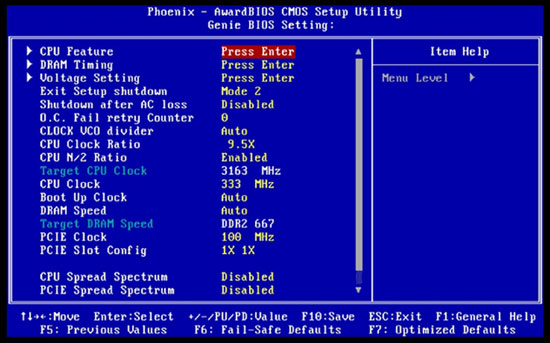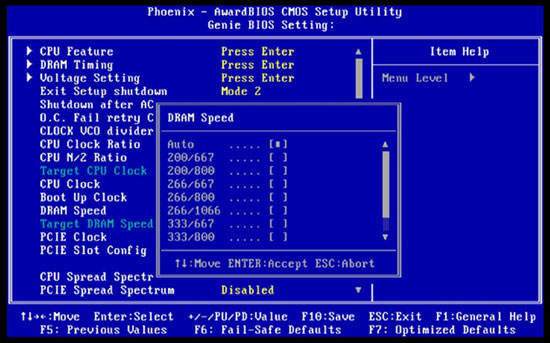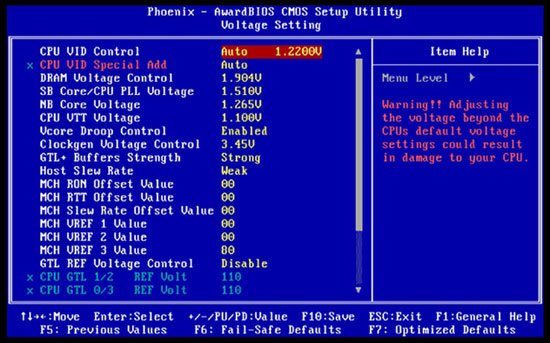DFI X48 LT T2R: Floats like a Butterfly…
by Rajinder Gill on April 28, 2008 4:00 AM EST- Posted in
- Motherboards
Important Performance Related BIOS Options
DFI supplied us with their latest BIOS for testing, which is set to go live sometime this week in a public beta. There are six new options for MCH termination and reference voltage adjustments. Three of the new settings over-complicate the BIOS to the point of being unnecessary so will probably be dropped for the public beta. The remaining three BIOS functions will be documented in this guide with the little information we have - even DFI is unsure as to their true nature and Intel has not been forthcoming with the information, shrouding these settings in further mystery.
For the most part, please note that we have decided to work on explanations of BIOS settings we deem worthy of user adjustment when overclocking. Settings we have left out were found to function adequately at the default/AUTO settings.
Genie BIOS Setting
 |
Boot Up Clock: Sets a safe user selected FSB speed for the system to revert to when an overzealous overclock fails.
PCIE Clock: Overclocking the PCIE bus can be useful for benchmarking, bringing small gains to overall scores. Unfortunately the X48/ICH9R combo does not have the potential for overall MHz we find with NVIDIA's 680i chipset which could run PCIE frequencies in excess of 150MHz for benchmarking. Generally, speeds below 110 MHz are safe enough to use, while SATA detection begins to fail when frequency is increased above 115MHz.
DRAM Speed
Available options are for this function can be seen in the following images:
 |
 |
We recommend that users with quad-core processors stay around 400FSB if they have the luxury of an unlocked multiplier. A 10x multiplier used at 400FSB will not require any GTL reference voltage adjustments to work and choosing the 266 strap will select a default tRD of 6 with some of the phases pulled down to 5 automatically in the BIOS. It really cannot get any simpler to set up one of these processors.
In fact, there are not any boards we know of that can quite eclipse this feat with 8GB of memory in place. We managed to run our board at default VMCH (1.25V) with a QX9650 and no less than 8GB of memory running DDR2-1000 and it was completely stable. Trying to beat this level of performance in any other way with 12MB cache quad-core CPUs is virtually impossible on this board. A default VTT voltage will get you close to 420 FSB, at which point a tRD adjustment as well as non-linear VTT increases for every 10FSB will follow.
We managed to get to 440FSB fully stable, but the VTT required was hardly safe for 24/7 use. As rule of thumb, do not exceed 1.34V (real), unless you have sub-zero cooling and are only running the board to perform a few benchmarks.
 |
CPU VID Control: This function sets the current CPU Vcore (range from 0.8V to 1.6V); this function can be used in conjunction with "CPU VID Special Add", for overvolting past 1.6V if required.
CPU VID Special Add: Used in conjunction with "CPU VID Control", sets a percentage of VCore over the applied voltage using the "CPU VID Control" function; maximum is 125% over 1.6V.
VCore Droop Control: We generally leave this function to its default setting of Enabled. Using Enabled here ensures that the applied VCore is never compromised by overshoot while the PWM circuit is recovering for a heavy transient load. Disabling this function will remove the droop but will also strain the MOSFETs as they struggle to maintain the applied Vcore level, which fluctuates thousands of times a second from the applied value even in light load conditions. The recovery process with no Voffset usually results in longer settling times, which actually gives rise to instability in certain cases - a BSOD during the windows load process is a classic example of this at work.
NBCore Voltage: Sets the core voltage for the MCH. For quad-core CPUs, operating under 420FSB may require nothing more than 1.32V. Over 430FSB, the VMCH requirement rises quite drastically, making the whole process futile - especially when we consider that a rather loose tRD value is required just to hold the board stable. For dual-core processors, if properly tuned the VMCH requirement can be as low as 1.4V for benchmarking while full stability will need circa 1.55V. A properly tuned NBGTL reference voltage value, VTT, and MCH reference values all serve to reduce the requirement of higher levels of VMCH. Anything over 510FSB using a 45nm processor will require in excess of 1.6V though.
CPU VTT Voltage: VTT is the termination voltage used to string data lines between the CPU FSB and the MCH. Increasing this voltage usually enables FSB frequency to be increased. Both 65nm and 45nm processors can benefit from a slight overvolt, bearing in mind that GTL voltage values must be tuned effectively any time an adjustment is made to VTT. For 65nm dual- and quad-core processors we recommend that users attempt to overclock their systems without any adjustment to VTT and GTL and see how far the board will clock.
We have heard of instances where pushing 65nm quad-core processors to their internal FSB limits before any adjustment of VTT/GTL is necessary when using this board. For 45nm quad-cores, we have already outlined our thoughts on the sensible operating point at the beginning of this guide, which just so happens to not require any adjustment to VTT or GTL values.
Pushing dual-core 45nm processors requires no real adjustment to VTT or GTL right up to 485FSB on our board. After this point, we find that although we can run VTT levels in the region of 1.18-1.28V to benchmark the board, heavy CPU loads result in a system freeze irrespective of GTL tuning until we raise VTT to around 1.34V (real) and set GTL reference values in the region of 61% of VTT. The bottom line here is that many users should never need to alter VTT/GTL levels unless they happen to have Satan's donkey for a processor or are shooting for high FSB levels for their particular processor class.
MCH Vref 1/2/3 Value
The defaults for these three settings are 00/00/80. DFI informed us that all three settings must be moved in unison, i.e. the ratio between all three settings should be maintained if making any adjustments. Up to 500 FSB, adjustment of these three settings is not usually necessary (though the FSB threshold for required adjustment may be lower for quad-cores). Unfortunately, there is little information available to us as to exactly which part of the MCH is driven by these reference voltages.
However, through some fiddling, we have found that a value of 30/30/B0 works quite well on our board once beyond 500FSB with a 45nm dual-core CPU. Effects can be marginal at times and at others provide the MCH with enough offset to boot into the OS and allow a benchmark to run. With a hexadecimal scale ranging from 00 to FF, the permutations for adjustment are almost limitless.
We found values over 40/40/C0 did not provide us with any additional gain. Properly set, the ability of the board to run low levels of VMCH may become apparent for those who run just benchmarks. We managed to 3D benchmark our board right down at 1.4VMCH at 500FSB and 4GHz with an E8500 CPU with 4GB of memory when this setting was tuned for our board and parts combination, something we have not be able to do on any other X48 board in DDR2 form.










24 Comments
View All Comments
Ephebus - Tuesday, April 29, 2008 - link
I remember a time when I was considering the purchase of a midrange ASUS motherboard with a reasonable set of overclocking options in the BIOS but no PCI-E clock setting, and there was no information on the specifications page or the manual as to how that setting would behave when overclocking. I then wrote to ASUS asking if the PCI-E clock was always locked by the board at 100 or if it would vary according to the CPU clock setting, and was actually told by an ASUS support "technician" to "go read a book on overclocking". I managed to get the info later on a forum from a person who owned the board and was kind enough to check it out for me. And that is, when ASUS support doesn't simply delete your support inquiry.With DFI I've managed to actually have short conversations with the technical support staff in the past, was able to report minor BIOS bugs and see them fixed on the next release, etc., so at least for me it's not just a question of whether a DFI motherboard can reach a few MHz more than an ASUS competitor or not on this or that benchmark, it's also all about the feeling of satisfaction from owning a product made by a company that has this kind of attitude towards users, and that always does their best to meet the needs and wishes of enhusiasts. I'll gladly pay more for a DFI product anytime.
Intelman07 - Monday, April 28, 2008 - link
Is there a reason Anandtech reconmends ~400FSB for quad core, does a lower multiplier and a higher FSB increase performance more in a quad core chip?Rajinder Gill - Monday, April 28, 2008 - link
Hi Intelman07,This applies in relation to the FSB limits of the quad cores only ON THIS board; 400 FSB at a trd running near 5-6 will give you a read delay time of around 13ns. Anything over 420 FSB needs a hike in trd while 440+ you need to be looking twoards a trd of 8 which is a delay of 17ns. The drop in write/copy speed bandwidth by reverting to 400FSB is only 500mbs while reads gain 500mbs running the lower tRD (swings and roundabouts). Now factor the VTT and VMCH requiremnts of the higher FSB and it becomes to click.
For more insight into this, 2 of our articles here will explain the fundammnetals and reasoning a little better.
http://www.anandtech.com/mb/showdoc.aspx?i=3208&am...">http://www.anandtech.com/mb/showdoc.aspx?i=3208&am...
and also logical approach to system tuning using Kris' excellent groundwork.
http://www.anandtech.com/cpuchipsets/showdoc.aspx?...">http://www.anandtech.com/cpuchipsets/showdoc.aspx?...
Other boards which vcan hit higher FSB's and low tRDs change these rules a little. But for the most part, the truth is that FSB overcloking on the quads and Joe Public - 400FSB really is realistic and attainable with real stability - and this is important to a majority of our readers. Of course, we still use our cascades from time to time and hammer the boards real hard without any of the logic written here applied.
The interetsing part comes as no surprise - yup - this all favors unlocked multiplier processors aka QX9650 and 9770 class, just up the FSB - keep the tRD low and hey presto!
The beauty of this board is that it gets close to that tRD 12.5ns latency time at 400FSB at 1.25VMCH and 8GB of memory with no need for GTL tuning- easy as pie- with performance that you can't swing anywhere else using a 12mb cache quad on this board.
Hope that clears it up a little..
regards
Raja
Bozo Galora - Monday, April 28, 2008 - link
Another great article by AT's best reviewer.I have read somewhere DFI's top X48 board gonna have ICH10R and cost ~$400??
Slash3 - Monday, April 28, 2008 - link
Page 2 states "The expansion slot layout is comprised of three PCI Express x16 slots (two x16 and one x4 slot), and three PCI slots."The board itself has 3 physical PCI-E 16x slots and 1 PCI-E 4x slot though, so the sentence is kind of ambiguous.
takumsawsherman - Monday, April 28, 2008 - link
It's the wicked fast 400Mbps version, rather than 800Mbps. Wouldn't want to advance the field. Nope, let's use the 10 year old ancient variety, rather than the 5 year old less ancient variety.I've got an even better idea... Why not throw in some USB 1.1 ports.
Rob94hawk - Monday, April 28, 2008 - link
I got all excited and then I saw DDR2....Might as well just replace PCIE with AGP while their at it.
Rajinder Gill - Monday, April 28, 2008 - link
Just contacted DFI, they are aiming at retail launch of the DDR3 version on the 20th May..Review sample boards should ship within the next week..
regards
Raja
Rajinder Gill - Monday, April 28, 2008 - link
EDIT: Make that early June for full retail (allowing for shipping time etc)..regards
Raja
Rob94hawk - Wednesday, April 30, 2008 - link
Will be looking forward to it. Thank you.